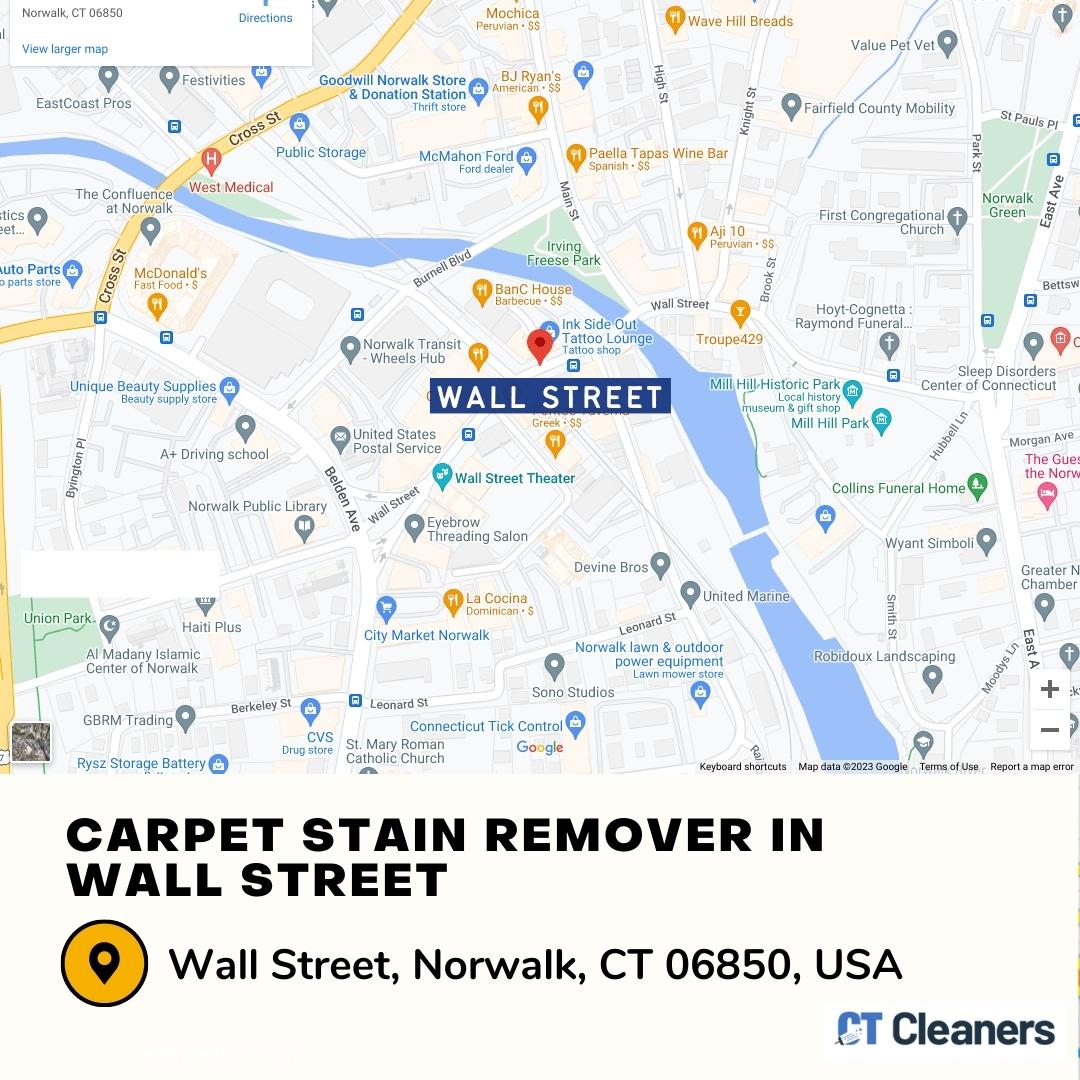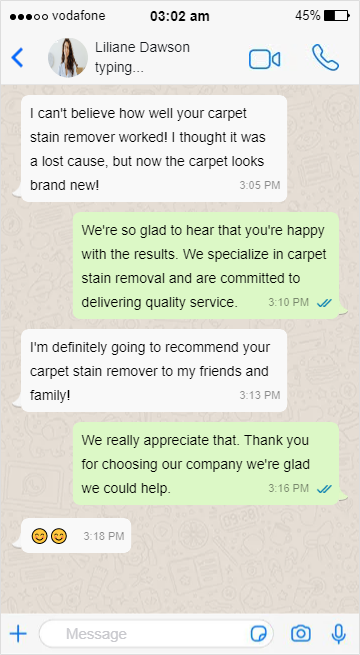Maintaining clean carpets in a commercial setting such as Wall Street is crucial for several reasons. Cleaning can remove the soil and dirt that causes wear on the carpet fibers and causes discoloration.
Furthermore, it’s an important step in an overall building maintenance plan, as dirty carpets can also contribute to poor indoor air quality. Proper cleaning and maintenance can also help to create a safer, healthier, and more pleasant working environment.

Types of Carpet Stains
Carpet stains are a common problem for many homeowners and commercial property owners. They can come from a variety of sources, such as spills, pet accidents, and tracked-in dirt, and can take many different forms, from dark discolorations to unpleasant odors.
Common types of carpet stains include those caused by pet urine, coffee, red wine, ink, grease, and oil, and biological substances such as mold and mildew.
Each type of stain requires a different approach and solution to remove, but prompt action can often help to minimize the damage and prevent permanent stains.
Understanding the different types of stains and how to properly remove them is crucial for maintaining the appearance and longevity of your carpet and upholstery.
- Pet Stains: Pet stains such as urine can cause discoloration and odors in carpets and upholstery, as well as damage the fibers if not cleaned up promptly. Even if pet urine is cleaned up, it still can leave behind lingering stains and odor that can only be removed professionally.
- Coffee Stains: Coffee can quickly leave behind noticeable stains on carpet and upholstery, particularly if it is not cleaned up right away. The dark color of coffee can be difficult to remove, and it may also leave behind a lingering odor.
- Red Wine Stains: Red wine can leave behind stubborn stains on carpet and upholstery, particularly if it is not cleaned up quickly. The tannins in red wine can cause discoloration in the fibers.
- Ink Stains: Ink can leave behind noticeable stains on carpet and upholstery, particularly if it is not cleaned up right away. The dark color of ink can be difficult to remove, and it may also penetrate deeply into the fibers, making it hard to remove.
- Grease and Oil Stains: Grease and oil can leave behind dark stains on carpet and upholstery that can be difficult to remove. It can come from food spills, from hands, or from machinery.
- Biological Stains: Biological stains, including those from mold, mildew, and other microorganisms, can leave behind noticeable discolorations on carpets and upholstery. These types of stains need to be treated quickly to prevent further growth and spread of microorganisms.
Homemade Carpet Stain Removers
Homemade carpet stain removers can be an effective and cost-efficient way to remove stains from carpets and upholstery. These solutions are typically made using common household items that are easily accessible and often less expensive than commercial products.
Some popular ingredients for homemade carpet stain removers include:
Baking Soda: Baking soda can be used as a natural deodorizer and mild abrasive that can help to lift stains and remove odors.
To make a baking soda-based carpet stain remover, mix baking soda with water to create a paste, apply it to the stain, and then use a brush to scrub the area.
Once the stain has been removed, vacuum the area to remove the baking soda residue.
Vinegar: White vinegar is a natural deodorizer and cleaning agent that can be used to remove stains from carpets and upholstery.
Mix one part vinegar with one part water and apply it to the stain, then use a brush to scrub the area. Once the stain has been removed, use a clean, damp cloth to remove any remaining vinegar solution.
Lemon Juice: Lemon juice is a natural stain remover that can be used on a variety of different stains. Mix one part lemon juice with one part water, apply it to the stain, and then use a brush to scrub the area.
Once the stain has been removed, use a clean, damp cloth to remove any remaining lemon juice solution.
“I had carpet stains all over my carpet, but the carpet stain remover services I availed from this company left it looking brand new. The staff were really helpful and professional, and I am so happy with the results!”
– Sandra M., Wall Street
Cornstarch: Cornstarch can be used to absorb and remove grease and oil stains from carpet and upholstery.
Apply cornstarch to the stain, let it sit for 15-20 minutes, and then vacuum up the cornstarch.
Club soda: Club soda can be used to remove red wine or other colored liquid stains from carpet and upholstery. Simply apply the club soda directly to the stain and use a white cloth to blot the area.
Repeat if necessary and use a clean cloth and water to rinse the area after the stain is removed.
Pros And Cons Of Commercial Carpet Stain Removers
Commercial carpet stain removers are products specifically formulated to remove stains from carpets and upholstery. They are widely available in a variety of forms, including sprays, powders, and gels, and can be an effective solution for tackling tough stains.
However, as with any product, there are pros and cons to consider when using commercial carpet stain removers.
| Commercial Carpet Stain Removers | |
| Pros | Cons |
| Easy to purchase and use | Contain harsh chemicals |
| Effective at removing tough or persistent stains | Can cause damage or discoloration to carpets and upholstery |
| More effective for specific types of stains, such as pet urine or red wine | Can be quite expensive |
Pros:
- Convenience: Commercial carpet stain removers are readily available in stores and online, so they are easy to purchase and use.
- Effectiveness: They are specifically formulated to remove a wide range of stains, which means that they can be quite effective at removing tough or persistent stains.
- Specialized solution: Many commercial stain removers are formulated to target specific types of stains, such as pet urine or red wine, which can make them more effective for those specific stains
Cons:
- Chemical content: Many commercial carpet stain removers contain harsh chemicals that can be harmful to the environment, as well as to the people and pets living in the home or office.
- Damage to delicate materials: Some commercial products can be too harsh for delicate fibers, such as those found in Persian rugs and some upholstery, which can cause damage or discoloration.
- Cost: Commercial carpet stain removers can be quite expensive, especially when used frequently or in large quantities.
In conclusion, keeping carpets clean and stain-free in a commercial setting like Wall Street is crucial for creating a positive impression, improving indoor air quality, and prolonging the life of the carpets.
The different types of stains such as pet urine, coffee, red wine, ink, grease, and oil, and biological substances like mold and mildew each require a different approach and solution to remove.
Homemade carpet stain removers made from common household items can be an effective and cost-efficient way to remove stains, but commercial and specialized products can be needed for tougher or specific stains.
However, it’s important to be aware of the drawbacks of using commercial products, particularly when dealing with more delicate fibers or expensive materials like Persian rugs.
In such cases, it may be best to seek the services of professional carpet cleaning on Wall Street.
They have specialized equipment and techniques that can effectively remove stains without damaging the fibers, and also ensure the overall cleanliness and hygiene of the carpets, creating a better working environment for all.
Our latest work









